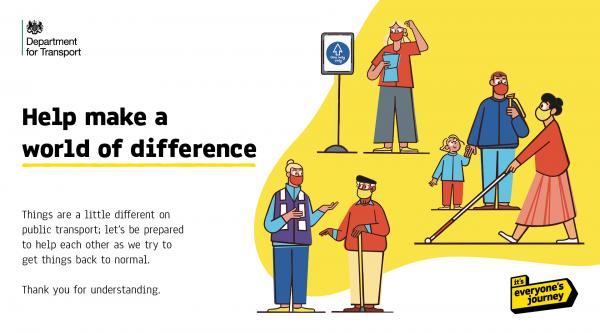Transport and travelling tips when someone has dementia
There are ways to support a person with dementia when travelling. These will depend on the type of transport being used.
- Holidays and dementia – things to consider
- Accessible types of holiday for people with dementia
- Preparing and packing for a holiday when someone has dementia
- You are here: Transport and travelling tips when someone has dementia
- Holidays and dementia – tips for during and after the holiday
- Holidays and dementia – financial help and legal protection
- Holidays and dementia – useful organisations
Holidays and travelling
People with dementia can have difficulties with planning and remembering the details of the journey ahead. This can put additional pressure on those travelling with them.
Tips for the journey
- If you’re travelling by car and you’re likely to be on the road for a while, think of ways to make the journey an interesting part of the holiday. For example, you could stop to have nice food or visit interesting places on the way.
- Plan for toilet breaks during the journey. If you are travelling by car, check the route for stops that have accessible toilets.
- If you have to travel to an airport or railway station, give yourself enough time to get there early. This will make the journey less stressful for you and for the person you care for. Arriving earlier also means shorter queues or waiting times, which may make your journey easier.
- Busy places can be more confusing for people with dementia. You might want to consider travelling at times when fewer people travel – avoiding weekends at the height of summer, for example.
- Stations and airports can be confusing places. It can be easy to get lost or to lose touch with someone. If you are travelling with someone with dementia, always make a note of what they are wearing and carry a recent photograph of them. If you have their permission, you could also take a photo of the person each morning that you’re on holiday – this could help if any problems arise on that day.
- If you need help, look for people who are wearing official uniforms (for example, security staff, airline counter staff or train conductors).
- In the UK, a range of places including airports and railway stations now use a sunflower lanyard scheme for people with hidden disabilities. This is a way of discreetly signalling to staff that assistance may be needed. Some airports, railway stations and large supermarkets now offer these lanyards for free. You can also buy one from the Hidden Disabilities store.
Different types of transport
Depending on the way you choose to travel and the specific needs of the person with dementia, there are ways to support them. Suggestions for different types of transport are included here.
Tips for travelling by air
- If you are flying, you may need to tell the airline that your travelling companion has dementia. Most airlines say that people with a stable condition do not require medical clearance in order to fly. However, you should check what medical information the airline needs when you are booking your flights.
- Before booking, think about what help the different airlines can give you and check whether the cost of any assistance is included in the price of your ticket. Many airlines can offer support from your arrival at the airport. For example, they may be able to accompany you from the car park, train station or taxi stand if you set this up in advance.
- If the airline cannot help, the airport may be able to. Many airports can give information about the facilities they offer. This includes information for people with different needs. Contact the airport or visit their website to find out more.
- If you have luggage to check in, it may be a good idea to do that as soon as you arrive at the airport. Once you are checked in and through airport security, you can relax inside the terminal.
- Priority boarding is often offered for people with disabilities – this would include people living with dementia. Check this with the airline or with airport staff.
- When booking plane tickets, make sure that you are seated next to the person you care for. Some airlines charge for seat allocations but they may be able to arrange for you and the person to sit together for free. Let the airline know about the person’s needs when you book.
- If the person is likely to walk about, you could ask airline staff if you can sit in the aisle seat, so that you’re aware if the person needs or wants to get out of their seat.
- Some people with dementia may find noise-cancelling headphones and familiar music calming if travelling by plane is unsettling.
- It could be helpful to have some favourite snacks in your hand luggage in case of long waits or as a distraction on the flight.
- If you or the person you care for use a wheelchair, check the airline’s policy on this. They may need you to transfer to an airline wheelchair when you check in.
- If your flight is cancelled and you or the person with dementia needs some rest, ask the airline to help arrange this for you. This is a good reason to tell the airline of any medical conditions before you travel.
- You should pack some essentials in your carry-on bag, in case your flight is delayed or your luggage is late arriving. Take the belongings you both need to feel comfortable (such as a change of underwear or a toothbrush) along with any medication that you might need.
Tips for travelling by coach or train
- If you are travelling by coach or train, a member of staff should be able to help with carrying and loading your luggage into the storage area or baggage racks. You should keep all valuables, tickets and medication with you in a separate bag.
- Many coach and rail companies run their own services for travellers who need extra support. This may include meeting you at the station in advance, or helping you find connecting trains or coaches. They can also provide ramps or help you to carry luggage. This can be set up during or after booking, as long as it is several days before the journey. Contact the company you are travelling with to find out what they offer.
- Make sure to arrange assistance for the return journey as well, if you will need it.
- It’s worth noting that coaches sometimes have a toilet that is difficult to access for people with mobility issues. Check what toilet facilities are available with the company ahead of time as it may mean that you have to use different transport.
- A number of specialist companies offer UK and European coach travel with fully accessible vehicles for people who use a wheelchair. For more information contact Tourism for All.
Tips for travelling by boat or ship
- If you are travelling by boat or ship, check with the operator whether you need to get medical clearance for the journey. Tell them when you book your ticket what assistance you will need.
- When on board, make sure the person has their cabin number on them at all times.
- For some people with dementia, a tour on a cruise ship can be a good option as the longer stay allows time to settle into a daily routine.
- Cruise ships also offer activities and entertainment as part of the experience. If the ship stops at different locations and allows passengers to leave and return, such a trip could also allow you to travel more widely without having to go on multiple separate journeys. You may be able to find cruise ships that are more inclusive for people living with dementia.
- If you are booking a cruise, you should ask how accessible the ship is. Some cruise ships are very large and can be disorientating. It could be worth booking on a smaller ship if you think this will make it easier for you and the person with dementia.
Tips for travelling by car
- Travelling by car may be a good option for people living with dementia as it allows for more flexibility, such as being able to travel with more luggage. You can also stop for breaks when needed and plan the most suitable route for you and the person with dementia.
- If you are planning a long car journey, try not to travel for too long before having a break. Plan your journey carefully, factoring in regular breaks from driving. Listen to traffic updates before you set off. Try to ensure that everyone is comfortable and that seatbelts are properly fitted.
- If the person with dementia dislikes travelling by car, consider whether some familiar background music or an audiobook may help them to settle. If they are upset by the noise from traffic, try to travel at times when the roads will be less busy or use quieter routes.
- If you have safety concerns about the person with dementia becoming agitated when you are driving, you could ask another person to come with you and sit with them.
- You may be worried that the person with dementia will do something unsafe, such as open the car doors or unbuckle their seatbelt when you are driving. If this is the case, you could consider using the safety locks in the back seat or covering the buckle on their seatbelt to make it less visible. You should only do this if the person consents to it. If they do not have the mental capacity to consent, only do this if it is in the person’s best interests.
- If you are planning to stop at motorway service areas, be aware that these can be big and confusing and it is easy to get lost or separated from travelling companions. It could help to give the person with dementia a note of the model, colour and registration number of the car that they can keep with them (a clear photograph would also work). Stay together where possible.
Legal protection for people living with dementia
There are laws that protect the rights of people affected by dementia when travelling. These mean that there is some support that travel services must provide.
- Page last reviewed:






